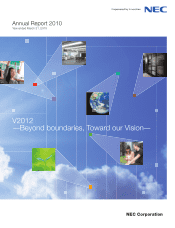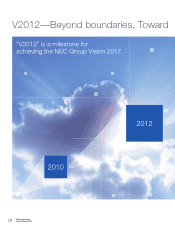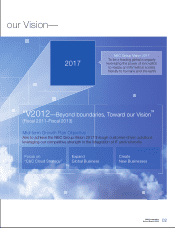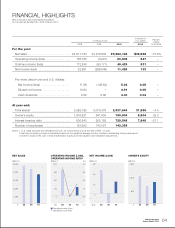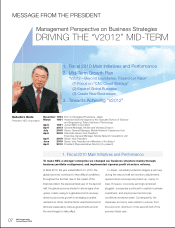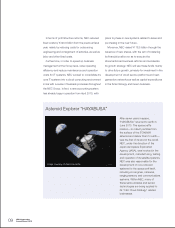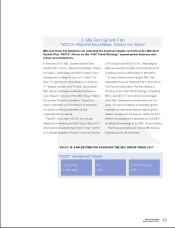NEC 2010 Annual Report Download - page 10
Download and view the complete annual report
Please find page 10 of the 2010 NEC annual report below. You can navigate through the pages in the report by either clicking on the pages listed below, or by using the keyword search tool below to find specific information within the annual report.
In terms of profit structure reforms, NEC reduced
fixed costs by ¥320.9 billion from the previous fiscal
year, mainly by reducing costs for outsourcing
engineering and consignment of activities, as well as
labor and other fixed costs.
Furthermore, in order to speed up business
management at the Group level, raise operating
efficiency and reduce maintenance and operation
costs for IT systems, NEC worked to consolidate its
core IT systems into a cloud computing environment
in line with a review of business processes throughout
the NEC Group. In fact, a new accounting system
has already begun operation from April 2010, with
plans to phase in new systems related to sales and
purchasing in the near future.
Moreover, NEC raised ¥118.5 billion through the
issuance of new shares, with the aim of bolstering
its financial position so as to execute the
aforementioned business reforms and accelerate
its growth strategy. NEC will use these funds mainly
to drive future growth, primarily for investment in the
development of cloud service platforms and next-
generation networks as well as capital expenditures
in the Smart Energy and Green business.
After seven years in space,
“ HAYABUSA” returned to earth in
June 2010. The spacecraft’s
mission—to collect particles from
the surface of the ITOKAWA
asteroid and deliver them to earth—
was the first of its kind in the world.
NEC, under the direction of the
Japan Aerospace Exploration
Agency (JAXA), was involved in the
development, manufacturing, testing
and operation of its satellite systems.
NEC was also responsible for the
development of core onboard
systems for the spacecraft itself,
including ion engines, cameras,
ranging sensors, and communications
systems. Within NEC, many of
these same wireless and sensor
technologies are being applied to
its “C&C Cloud Strategy” related
businesses.
Image courtesy of Akihiro Ikeshita
Asteroid Explorer “HAYABUSA”
09 NEC Corporation
Annual Report 2010

